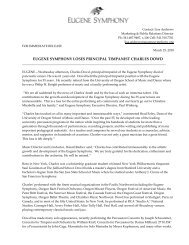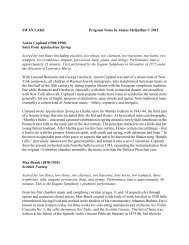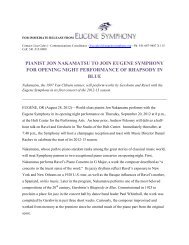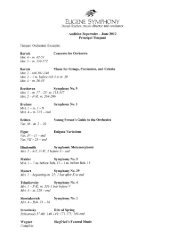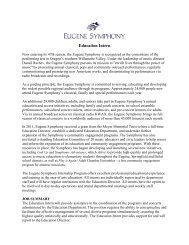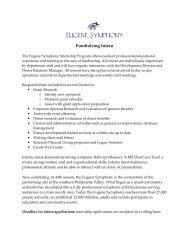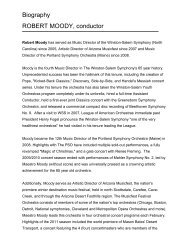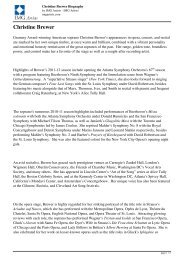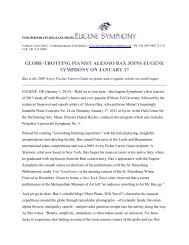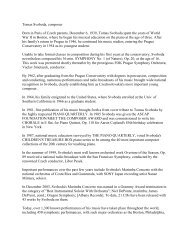The Orchestra Sings - Eugene Symphony
The Orchestra Sings - Eugene Symphony
The Orchestra Sings - Eugene Symphony
Create successful ePaper yourself
Turn your PDF publications into a flip-book with our unique Google optimized e-Paper software.
Support provided by:<br />
Gorgie Hofma<br />
Danail Rachev, music director and conductor<br />
City of <strong>Eugene</strong>/<br />
Hult Center for the Performing Arts<br />
A youth concert for elementary<br />
school students designed by<br />
Carnegie Hall.<br />
Narrated by William Hulings<br />
Tuesday, November 13 and<br />
Wednesday, November 14, 2012
<strong>The</strong> <strong>Orchestra</strong> <strong>Sings</strong><br />
What is <strong>The</strong> <strong>Orchestra</strong> <strong>Sings</strong>?<br />
<strong>The</strong> <strong>Orchestra</strong> <strong>Sings</strong> , a youth concert designed by Carnegie Hall, is part<br />
of a larger program called Link Up which assists students in discovering<br />
how composers and musicians play with elements of rhythm, including<br />
creating patterns of sound and silence that are expressive and exciting.<br />
<strong>The</strong> <strong>Eugene</strong> <strong>Symphony</strong> has partnered with Carnegie Hall to provide Link<br />
Up to third through fifth graders in area afterschool programs. Exploring a<br />
range of orchestral repertoire, students sing, play the recorder, compose,<br />
and perform on-stage with the <strong>Eugene</strong> <strong>Symphony</strong> as part of <strong>The</strong><br />
<strong>Orchestra</strong> <strong>Sings</strong> youth concert.<br />
We invite you and your students to sing along with us and our afterschool<br />
partner programs in a lively and educational concert experience like no<br />
other!
<strong>The</strong> <strong>Orchestra</strong> <strong>Sings</strong><br />
October 24, 2012<br />
Dear Educator,<br />
We look forward to sharing our Elementary Youth Concert, <strong>The</strong> <strong>Orchestra</strong><br />
<strong>Sings</strong>, with you on November 13 & 14. To help you prepare for your students’<br />
performance in this special concert, we, along with Carnegie Hall, have<br />
provided you with scores of the music to be sung with the orchestra, as well as<br />
historical information on each piece.<br />
We find that students who receive an early introduction to the program learn<br />
more from our concerts. You are encouraged to make as many copies of this<br />
packet as you wish.<br />
Thank you for your continued support of our youth concerts. I will email a<br />
survey to you following the concert. We appreciate your feedback.<br />
Sincerely,<br />
Jennifer Diaz<br />
Education Director
<strong>The</strong> <strong>Orchestra</strong> <strong>Sings</strong><br />
Dear Students,<br />
I’m so glad that you’re coming to the <strong>Eugene</strong><br />
<strong>Symphony</strong>’s Youth Concert! I will be the musician<br />
conducting the orchestra during the performance.<br />
We are looking forward to guiding you through an<br />
interactive exploration of melody in music, singing<br />
along with the us on “Ode to Joy” and “Simple<br />
Gifts.” I hope you enjoy learning the pieces as<br />
much as you enjoy performing with the <strong>Symphony</strong>!<br />
I look forward to sharing this special music with<br />
you.<br />
Danail Rachev<br />
Conductor
<strong>The</strong> <strong>Orchestra</strong> <strong>Sings</strong><br />
THE ORCHESTRA SINGS<br />
CONCERT PROGRAM<br />
Bizet Farandole from L’Arlésienne<br />
Dvorak Largo from the New World <strong>Symphony</strong>, arr. Cabaniss<br />
Brackett “Simple Gifts”*<br />
Beethoven “Ode to Joy”, arr. Cabaniss*<br />
Stravinsky “Finale” from <strong>The</strong> Firebird Suite<br />
*Denotes pieces students may sing along with. Please refer to the accompanying scores.
<strong>The</strong> <strong>Orchestra</strong> <strong>Sings</strong><br />
Guide to Audience Behavior<br />
1. Leave all electronic devices on the school bus.<br />
2. Once you have entered the Hult Center, you are expected to speak in a<br />
moderate tone of voice. No yelling, please.<br />
3. Stay with your teacher or assigned chaperone while waiting to be seated.<br />
4. Once the lights dim inside the concert hall, all talking should stop so that the<br />
orchestra may tune. <strong>The</strong> concert host will invite you to participate in the<br />
concert once it is appropriate.<br />
5. Show your appreciation for the orchestra by applauding when the conductor<br />
comes on stage and in between each piece.<br />
6. Get into the music and feel the beat in your body. Participate when it is your<br />
turn!<br />
7. Focus on the instruments. What do you hear? What do you see?<br />
In-class Discussions & Activities<br />
Split the class into three groups: performers, audience, and observers. <strong>The</strong><br />
performers can play, sing, or even read something that the class is studying. <strong>The</strong><br />
observers watch and take notes “fishbowl” style. What can they observe about<br />
the relationship between the audience and the performers?<br />
Draw out reactions from the performers. Begin to develop empathy for<br />
performers as an audience member.<br />
• How does it make you feel when people aren‟t paying attention?<br />
• How does it feel when you don‟t get the applause you deserve?
<strong>The</strong> <strong>Orchestra</strong> <strong>Sings</strong><br />
Farandole from L’Arlesienne<br />
About L’Arlesienne<br />
L’Arlesienne, translated as “<strong>The</strong> Girl<br />
from Arles”, is a play written by<br />
Alphonse Daudet. Bizet was<br />
commissioned, or paid, to compose<br />
the music for the play, which was<br />
premiered on October 1, 1872 in<br />
Paris. Bizet composed a total of 27<br />
pieces for the play, including pieces<br />
for voice, chorus, and small<br />
orchestra.<br />
Though the play was unsuccessful,<br />
the music for the play lives on as a<br />
two-suite arrangement for full<br />
orchestra.<br />
Georges Bizet<br />
1838-1875<br />
• Born in Paris, France as<br />
Alexandre César Léopold Bizet<br />
but later baptized as Georges,<br />
which is the name he kept for<br />
the rest of his life.<br />
• Began studying at the Paris<br />
Conservatoire (a college of<br />
music and dance) when he<br />
was only nine years old.<br />
• Georges won several awards<br />
and competitions while<br />
studying at the Conservatoire.<br />
• Best known as an opera<br />
composer.<br />
• Bizet’s best-known work is the<br />
opera, Carmen.
<strong>The</strong> <strong>Orchestra</strong> <strong>Sings</strong><br />
Farandole from L’Arlesienne<br />
Set in Provence, France, L’Arlesienne<br />
is about a girl from Arles that was<br />
loved by a young peasant boy. <strong>The</strong><br />
two are to marry but the peasant<br />
boy soon realizes that the girl from<br />
Arles loves another.<br />
What is a farandole?<br />
<strong>The</strong> farandole is a fast chain dance<br />
that was popular in Nice, France. <strong>The</strong><br />
dance music is typically played by a<br />
flute and drum. Dancers hold hands<br />
while skipping, walking, or running.<br />
Watch the farandole dance<br />
performed during the first minute of this<br />
video:<br />
http://www.youtube.com/watch?v=M<br />
f-yre31yfE<br />
Georges Bizet<br />
1838-1875<br />
In-class Discussions<br />
• Where is Arles? Explore its<br />
culture and history.<br />
• What is an opera?<br />
• What is a peasant? Discuss<br />
social class structures of the<br />
time.
<strong>The</strong> <strong>Orchestra</strong> <strong>Sings</strong><br />
Largo from the New World <strong>Symphony</strong><br />
About the Romantic Period<br />
<strong>The</strong> Romantic period succeeded the<br />
Classical period, and is generally<br />
thought to be from 1815-1900.<br />
Though the label may suggest<br />
otherwise, the term “romantic” does<br />
not refer to love, but rather writing<br />
with an abundance of passion and<br />
expression.<br />
What is a symphony?<br />
Traditionally, a symphony is a piece of<br />
music in three or more movements, or<br />
sections. However, in modern day, a<br />
symphony can also refer to an<br />
orchestra, such as the <strong>Eugene</strong><br />
<strong>Symphony</strong>.<br />
Antonín Dvořák<br />
1841-1904<br />
• Born in the Bohemian village of<br />
Nelahozeves , now part of the<br />
Czech Republic.<br />
• Studied organ, violin, and viola.<br />
• Self-taught composer.<br />
• Moved to America in 1892 to<br />
become director of the National<br />
Conservatory of Music.<br />
• He later moved back to Prague<br />
and became the director of the<br />
Prague Conservatory.<br />
• Considered the most prolific<br />
Czech composer to date.<br />
• Romantic era composer.
<strong>The</strong> <strong>Orchestra</strong> <strong>Sings</strong><br />
Largo from the New World <strong>Symphony</strong><br />
“Thousands upon thousands of people, and<br />
an everchanging sight! And you should hear<br />
all the kinds of music! … Well, America seems<br />
to have demonstrated all it is and all it is<br />
capable of! I haven‟t got enough words to<br />
describe it all.”<br />
When the New York Philharmonic hired<br />
Dvořák to write a symphony, he was<br />
inspired to blend traditional American<br />
sounds into his work, including the music of<br />
Native and African Americans, with<br />
Bohemian folk music.<br />
Largo is a movement within the <strong>Symphony</strong>,<br />
based on a spiritual-like song called “Goin’<br />
Home”.<br />
What is a spiritual?<br />
Spirituals are religious folk songs created<br />
and first sung by African American slaves<br />
to pass the time and relay secretive<br />
information to other slaves.<br />
Antonín Dvořák<br />
1841-1904<br />
In-class Discussions<br />
• Where is Bohemia on the<br />
map? Explore its culture &<br />
history.<br />
• What is an organ and what<br />
does it sound like? In what kind<br />
of venue is it most commonly<br />
used?<br />
• What does Native American<br />
and Bohemian folk music<br />
sound like? What kind of<br />
instruments were used during<br />
Dvořák’s time in each culture?<br />
• What was happening in visual<br />
arts, dance, and theater<br />
during Dvořák’s life?
<strong>The</strong> <strong>Orchestra</strong> <strong>Sings</strong><br />
“Simple Gifts”<br />
What is a Shaker?<br />
<strong>The</strong> United Society of Believers,<br />
commonly referred to as Shakers, are a<br />
religious group founded in England in<br />
1747. After their leader was imprisoned<br />
for her religious beliefs, she and her<br />
followers emigrated to the United<br />
States in 1774, searching for religious<br />
freedom.<br />
Shakers believe that religion is also a<br />
lifestyle, living in gender segregated<br />
housing but coming together for<br />
worship and work. <strong>The</strong>y lead a simple,<br />
self-sufficient community by living off of<br />
their land. At one point in time, there<br />
were over 5,000 Shakers but today only<br />
a handful remain in the Sabbathday<br />
Lake, Maine village.<br />
Joseph Brackett, Jr.<br />
1797-1882<br />
• Born in Cumberland, Maine<br />
into a Shaker community.<br />
• Primarily a church leader,<br />
Brackett did not compose<br />
many tunes.<br />
• Elder, or male leader, in his<br />
Shaker community<br />
<strong>The</strong> Shakers composed thousands<br />
of songs and choreographed many<br />
dances, primarily to be used during<br />
worship services.
<strong>The</strong> <strong>Orchestra</strong> <strong>Sings</strong><br />
“Simple Gifts”<br />
“Simple Gifts” is not a hymn, as it is<br />
traditionally referred, but rather a<br />
song. <strong>The</strong> difference? Shaker hymns<br />
have two or more verses while Shaker<br />
songs have only one verse.<br />
<strong>The</strong> last two lines indicate that this<br />
was a dance song:<br />
“To turn, turn will be our delight,<br />
„til by turning, turning we come „round<br />
right.”<br />
“Simple Gifts” is<br />
felt in four beats.<br />
To the left is the<br />
pattern the<br />
conductor will be<br />
conducting for<br />
this piece.<br />
Joseph Brackett, Jr.<br />
1797-1882<br />
In-class Discussions & Activities<br />
• What is a verse?<br />
• Write a second verse to the<br />
song.<br />
• Make up a dance to the song.<br />
• Imagine – how could you<br />
simplify your life?<br />
“Simple Gifts” was made by popular<br />
by Aaron Copland’s orchestral suite,<br />
Appalachian Spring, almost 100 years<br />
after the tune was composed.<br />
Watch the ballet here:<br />
http://www.youtube.com/watch?v=9<br />
1y-NEdTj-g
<strong>The</strong> <strong>Orchestra</strong> <strong>Sings</strong><br />
“Ode to Joy” from <strong>Symphony</strong> No. 9<br />
About the Classical Period<br />
<strong>The</strong> Classical period occurred<br />
after the Baroque period,<br />
generally thought of as between<br />
1750-1830. It is called the<br />
Classical period because artists<br />
and writers tried to emulate the<br />
artistic and literary heritage of<br />
classical Greece and Rome.<br />
Did you know?<br />
Beethoven was completely deaf when he<br />
composed his ninth symphony.<br />
Ludwig van Beethoven<br />
1770-1827<br />
• Born in Bonn, Germany in 1770,<br />
though his exact date of birth<br />
is not known.<br />
• Initially learned piano from his<br />
father.<br />
• He became the primary<br />
financial provider for his family<br />
by the time he was twelve by<br />
performing and composing<br />
music.<br />
• Acknowledged as one of the<br />
greatest composers of all time.<br />
• Classical era composer.
<strong>The</strong> <strong>Orchestra</strong> <strong>Sings</strong><br />
“Ode to Joy” from <strong>Symphony</strong> No. 9<br />
“Ode to Joy” is the final movement of<br />
Beethoven’s ninth (and last)<br />
symphony. It is the only movement<br />
within the symphony that features<br />
four solo vocalists and a chorus. <strong>The</strong><br />
text that the chorus sings (and that<br />
you’ll be singing at our youth<br />
concert!) is based on a poem written<br />
by Friedrich Schiller. <strong>The</strong> poem<br />
enthusiastically celebrates the<br />
brotherhood and unity of all<br />
mankind.<br />
Interesting fact…<br />
While conducting the premiere<br />
performance of <strong>Symphony</strong> No. 9,<br />
Beethoven was several measures off<br />
and could not hear that the orchestra<br />
had stopped playing. One of the<br />
vocalists had to turn him around to<br />
accept the audience’s applause.<br />
Ludwig van Beethoven<br />
1770-1827<br />
In-class Discussions<br />
• Where is Germany on the<br />
map? Explore its culture &<br />
history.<br />
• What causes hearing loss?<br />
• How do you think Beethoven<br />
was able to continue to<br />
compose, conduct, and<br />
perform after completely<br />
losing his hearing?<br />
• What was happening in visual<br />
arts, dance, and theater<br />
during Beethoven’s life?
<strong>The</strong> <strong>Orchestra</strong> <strong>Sings</strong><br />
“Finale” from <strong>The</strong> Firebird Suite<br />
In 1910, Igor Stravinsky partnered with<br />
choreographer Michael Folkine and<br />
storywriter Alexandre Benois to<br />
compose <strong>The</strong> Firebird, a ballet based<br />
on Russian fairy tales.<br />
Although the story takes place in<br />
Russia, the ballet was premiered in<br />
Paris by Ballets Russes.<br />
Soon after the ballet premiere,<br />
Stravinsky re-arranged the score for<br />
orchestra. <strong>The</strong> score underwent<br />
several revisions for smaller<br />
ensembles.<br />
Watch this excerpt of the ballet,<br />
performed by Northwest Ballet, which<br />
is based in Seattle:<br />
http://youtu.be/6h6WvIeodfs<br />
Igor Stravinsky<br />
1882-1971<br />
• Born in Oranienbaum, Russia<br />
and raised in Saint Petersburg,<br />
Russia.<br />
• As a shy and lonely young child,<br />
Stravinsky began studying piano,<br />
music theory, and composition.<br />
• Received a partial diploma in<br />
law.<br />
• Studied composition privately<br />
with Russian composer Rimsky-<br />
Korsakov.<br />
• <strong>The</strong> Firebird launched<br />
Stravinsky’s career as an<br />
international composer.<br />
• One of the most important and<br />
influential composers of the 20 th<br />
century.
<strong>The</strong> <strong>Orchestra</strong> <strong>Sings</strong><br />
“Finale” from <strong>The</strong> Firebird Suite<br />
<strong>The</strong> Firebird Story<br />
Prince Ivan is hunting near an enchanted castle, which belongs to a wicked magician named<br />
Kashchei the Immortal. Ivan catches the Firebird, a magical bird while she is taking golden apples<br />
from a nearby tree, and she begs for her freedom. In exchange, the Firebird offers Prince Ivan a<br />
magic feather from her golden tail that will protect him in times of trouble. Prince Ivan accepts the<br />
feather and sets the Firebird free. Whenever Ivan waves the magic feather, the Firebird will come to<br />
his rescue. Meanwhile, the evil magician Kashchei is having a good time capturing beautiful young<br />
women and turning handsome young men into stone statues. Ivan sees a beautiful princess and 12<br />
maidens outside the enchanted castle. Prince Ivan falls immediately in love with the princess. He<br />
wants her to go away with him, but the princess tells Ivan that she and her friends are captives of the<br />
evil magician. If anyone tries to rescue them, they will be turned into stone. <strong>The</strong> maidens are forced to<br />
return to the sorcerer’s castle, but the prince follows them.<br />
Ivan goes into the castle to fight the magician. He is captured, and just when the magician is going to<br />
turn him into stone, Prince Ivan remembers the magic feather and waves it. <strong>The</strong> Firebird returns and<br />
makes the magician and his servants do a wild dance, forcing them to dance faster and faster until<br />
they all collapse. <strong>The</strong> dance makes the servants and the evil magician too tired to hurt Ivan. <strong>The</strong><br />
Firebird then sings them to sleep with a lullaby. <strong>The</strong> Firebird whispers to Ivan to look for a magic egg,<br />
which is the source of all of the evil magician’s power. <strong>The</strong> prince finds the egg and smashes it, and<br />
the spell is broken. <strong>The</strong> princess, her friends, and all of the stone statues come back to life. Ivan and<br />
the princess live happily ever after.<br />
Material excerpted from lincolnsymphony.com/stravinskyplan.pdf and Carnegie Hall Weill Music Institute.
<strong>The</strong> <strong>Orchestra</strong> <strong>Sings</strong><br />
A Diagram of the <strong>Orchestra</strong>
<strong>The</strong> <strong>Orchestra</strong> <strong>Sings</strong><br />
WHAT IS THE ROLE OF<br />
THE CONDUCTOR?<br />
Every large ensemble has a conductor<br />
such as Danail Rachev (<strong>Eugene</strong><br />
<strong>Symphony</strong>). <strong>The</strong> conductor is not only<br />
the face of the orchestra, but also<br />
leads the organization with an artistic<br />
vision. For example, Danail decides<br />
which pieces the orchestra will perform<br />
for each concert, guides the musicians<br />
in performing the pieces to his<br />
interpretation, and keeps the ensemble<br />
playing together through his hand<br />
patterns.
<strong>The</strong> <strong>Orchestra</strong> <strong>Sings</strong><br />
Instrument Families<br />
<strong>The</strong> WOODWIND family includes the flute, clarinet,<br />
oboe, saxophone, and bassoon. This instrument family<br />
produces sound by blowing a vibrating column of air<br />
inside some form of tube. In the past, woodwind<br />
instruments were made from wood, but nowadays<br />
some instruments like the flute are made from metal.<br />
Woodwinds create a vibrating column of air in<br />
different ways. Flutes blow across the top of an open<br />
hole. Clarinets and saxophones blow between a reed<br />
– usually a small, flat piece of bamboo – against a<br />
fixed surface. That is why clarinets and saxophones<br />
are sometimes called “single-reed” instruments.<br />
Bassoons and oboes blow between two reeds that<br />
vibrate against each other. That is why bassoons and<br />
oboes are sometimes called “double-reed” instruments.<br />
Woodwinds usually change the pitch of<br />
their instruments by changing the length of the tube<br />
they blow the vibrating air through. <strong>The</strong>y most often<br />
change the length by opening and closing holes<br />
using keys on their instruments. Woodwind instruments<br />
are sometimes described as having a singing sound.<br />
<strong>The</strong>y are often used to play solo parts during<br />
symphonies when their unique tonal qualities can be<br />
heard even if the entire orchestra is playing.
<strong>The</strong> <strong>Orchestra</strong> <strong>Sings</strong><br />
Instrument Families<br />
Trumpet<br />
French Horn<br />
Trombone<br />
Tuba<br />
<strong>The</strong> BRASS family is one of the oldest families of the<br />
orchestra and includes the trumpet, french horn,<br />
trombone, and tuba, all of which are made of brass!<br />
Sound is produced on these instruments when a<br />
person’s lips buzz into a cup-shaped mouthpiece and<br />
produce vibrating air. <strong>The</strong> vibrating air then travels<br />
through a long metal tube that modifies and<br />
amplifies the vibrations. In order to change pitch,<br />
brass players use two techniques. One is to vary the<br />
speed with which they buzz their lips. <strong>The</strong> other is to<br />
change the length of the tubing that they blow air<br />
through. This is done by either pressing a key to open<br />
a valve, as with a trumpet, or by using a slide to<br />
physically increase or decrease the length of tubing,<br />
as with a trombone. Brass instruments are often<br />
described as having a sweet or round sound. <strong>The</strong>n<br />
can also play very loudly and are often used in the<br />
most exciting parts of a piece.
<strong>The</strong> <strong>Orchestra</strong> <strong>Sings</strong><br />
Instrument Families<br />
<strong>The</strong> STRING family is made up of the violin, viola, cello, bass and harp. Not<br />
surprisingly, instruments in this family produce sound by vibrating strings! <strong>The</strong> strings<br />
vibrate in two ways. Vibrations can be produced by using a bow (made from<br />
horsehair stretched on a wood stick) to rub the strings and produce vibrations. <strong>The</strong><br />
other way is to pluck the string, usually with the hand, a technique called pizzicato.<br />
<strong>The</strong> pitch is changed on string instruments by adjusting the length of the string. This is<br />
usually accomplished by putting fingers down at some point on the string to shorten<br />
the length of the vibrating string. String instruments have a very mellow, rich sound.<br />
<strong>The</strong>re are many string players in an orchestra because each instrument alone does<br />
not have a very loud sound compared to other instrument families. Strings often play<br />
a beautiful melody, but sometimes the strings play the harmony parts.
<strong>The</strong> <strong>Orchestra</strong> <strong>Sings</strong><br />
Instrument Families<br />
<strong>The</strong> PERCUSSION family is probably the<br />
most varied family in the orchestra. Sound<br />
on percussion instruments is created by<br />
physically hitting, rubbing or shaking a solid<br />
material, like a metal triangle or a<br />
membrane (like the top of a snare drum).<br />
Membranes were once made from animal<br />
skins, but today most drums use a synthetic<br />
material. Only a few percussion<br />
instruments produce a specific pitch.<br />
Pitched percussion instruments that use a<br />
membrane, like the timpani, change pitch<br />
when the tension of the membrane is<br />
altered. Percussion instruments usually<br />
provide rhythm for the music. Many<br />
people don’t know that the percussion<br />
family also includes the piano.
<strong>The</strong> <strong>Orchestra</strong> <strong>Sings</strong><br />
Instrument Scramble and Family Identification<br />
Unscramble the words in the first column to identify the musical instrument in the<br />
second column. In the third column, write the name of the family (woodwind,<br />
brass, strings, percussion) to which the instrument belongs.<br />
1. aiovl<br />
2. ossabon<br />
3. atbu<br />
4. lelvoioocnl<br />
5. tuefl<br />
6. aesnr mrdu<br />
7. rmptuet<br />
8. pniiatm<br />
9. tcernlai<br />
10. bmetonro<br />
11. aylscmb<br />
Instrument Family
<strong>The</strong> <strong>Orchestra</strong> <strong>Sings</strong><br />
Instrument Scramble and Family Identification<br />
Answer Key<br />
Instrument Family<br />
1. aiovl viola string<br />
2. ossabon bassoon woodwind<br />
3. atbu tuba brass<br />
4. lelvoioocnl violoncello string<br />
5. tuefl flute woodwind<br />
6. aesnr mrdu snare drum percussion<br />
7. rmptuet trumpet brass<br />
8. pniiatm timpani percussion
<strong>The</strong> <strong>Orchestra</strong> <strong>Sings</strong><br />
Across<br />
3. Religious group founded in England whose followers composed thousands of songs for<br />
worship.<br />
6. Term that refers to instruments that require the musician to blow between two reeds.<br />
7. Piece of music in three or more movements.<br />
9. Instrument family whose sound is created by physically hitting, rubbing, or shaking a<br />
solid material.<br />
10. One of the greatest composers of all time who went deaf toward the end of his life.<br />
12. A period when artists tried to copy the heritage of Greece and Rome.<br />
Down<br />
1. Leader that keeps the ensemble playing together through his hand patterns.<br />
2. Instrument that requires the musician to buzz their lips into a cup-shaped mouthpiece.<br />
3. Instrument family whose sound is produced by vibrating strings.<br />
4. Shaker dance song felt in four beats.<br />
5. Folk songs created by slaves to pass time.<br />
8. Movement of a symphony that features a chorus.<br />
11. A ballet based on Russian fairy tales.



